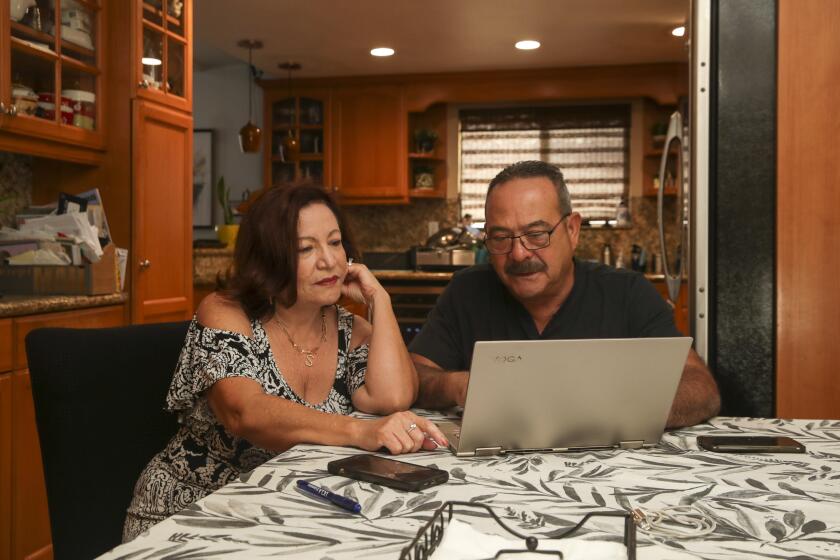Need to raid your retirement for quick cash? Here are ways to limit the financial hit

- Share via
Raiding your retirement accounts can be expensive.
Withdrawing money before age 59½ typically triggers income taxes, a 10% federal penalty and — worst of all — the loss of future tax-deferred compounded returns. A 30-year-old who withdraws $1,000 from an individual retirement account or 401(k) could lose more than $11,000 in future retirement money, assuming 7% average annual returns.
In the past, there were a few ways you could avoid the penalty. Congress recently added several more, and some of those exceptions allow you to repay the money within three years.
That would allow you to get a refund of the taxes you paid and — best of all — allow the money to start growing again, tax deferred, for your future.
You’re still better off leaving retirement funds alone for retirement, said Erin Itkoe, director of financial planning at Tarbox Family Office, a wealth management firm in Scottsdale, Ariz. If you can’t, though, you could at least limit the damage from taking the money out early, she said.
More than 7 million Californians have had no access to a workplace retirement program. Can the CalSavers program help?
What is Secure 2.0?
The new penalty exceptions are part of Secure 2.0, a package of retirement plan changes that Congress passed late last year. Some exceptions are available for your IRA now, while others take effect in coming years, said David Certner, legislative counsel for AARP. The exceptions also can apply to workplace plans, such as 401(k)s or 403(b)s, but your employer may need to opt in, so check with your human resources department, Certner said.
However, the repayment option still isn’t available for most penalty exceptions. For example, you can avoid the penalty if you withdraw $10,000 from an IRA for a first-time home purchase or to pay higher education expenses, but you won’t be able to repay the money later and get the taxes refunded.
Disasters, terminal illness, family expansion
One new penalty exception that allows for repayment is for disasters. People who live in a federally declared disaster area and suffer an economic loss can withdraw up to $22,000 penalty-free. Income taxes still have to be paid on the withdrawal, but the income can be spread over three years to reduce the potential tax impact. This exemption was made retroactive to Jan. 26, 2021.
Another potentially large exemption with the repayment option is one for terminal illness. Effective this year, the 10% penalty is waived for people whose doctor certifies that they are expected to die within seven years, said Itkoe, who’s also a certified public accountant serving on the American Institute of CPAs’ personal financial planning executive committee. There’s no limit on how much can be withdrawn.
A three-year repayment period now applies to the penalty exception when you have or adopt a child. This exception allows each parent a $5,000 withdrawal within the 12 months after a child is born or adopted.
The higher earner’s benefit determines what the survivor gets. By delaying Social Security, the higher earner boosts how much the remaining spouse will have to make ends meet.
Exceptions coming next year
Next year, the 10% penalty is waived for victims of domestic abuse. The penalty-free withdrawal is limited to the lesser of $10,000 or 50% of the account’s value and can be repaid over three years.
Also effective next year is a penalty-free distribution of up to $1,000 for some emergency expenses. People can take one such withdrawal per year if the money is repaid. Otherwise, only one distribution is allowed every three years.
Note that both of these exceptions are “self-certified.” That means you provide a written statement asserting that you meet the requirements without having to supply other documentation or proof, Itkoe said.
Other exceptions coming up
A penalty exception to pay for long-term care insurance kicks in for 2026, but it applies only to workplace plans, not IRAs. The withdrawal — which is limited to the lesser of $2,500 or 10% of the account balance — can be used only to pay insurance premiums, not to pay for the actual care, Certner said.
Secure 2.0 also expanded the “public safety employee” exception for early withdrawals from workplace plans.
Whether it’s going back to work part time, moving in with roommates or making do with less, older Americans are getting creative about retirement.
In the past, the 10% penalty didn’t apply for withdrawals from workplace plans if the worker left a job in the year they turn 55 or older, or age 50 for public safety employees. Now, private sector firefighters and state and local corrections officers also can qualify for the public safety exception after they turn 50. In addition, public safety employees with at least 25 years of service with the employer sponsoring the plan can now avoid the penalty regardless of their age.
This is just a summary of the new penalty exceptions. The rules are complex enough that people should consult a tax professional before taking a withdrawal, Itkoe said. The tax pro also can help file an amended tax return if the withdrawal is repaid.
But no one should assume that the exceptions make retirement plan withdrawals a good idea, because most people won’t pay the money back even if they have the option to do so, she said.
“Drawing from a retirement account should always be a last resort,” Itkoe said.
Liz Weston writes for personal finance website NerdWallet. This article was distributed by the Associated Press.
More to Read
Inside the business of entertainment
The Wide Shot brings you news, analysis and insights on everything from streaming wars to production — and what it all means for the future.
You may occasionally receive promotional content from the Los Angeles Times.













